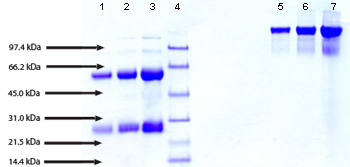Recombinant Human Group XVI Phospholipase A1/A2/PLA2G16
| Product name: | Recombinant Human Group XVI Phospholipase A1/A2/PLA2G16 |
| Source: | E.coli |
| Purity: | Greater than 95% as determined by reducing SDS-PAGE. |
| Buffer Formulation: | Supplied as a 0.2 μm filtered solution of 20mM TrisHCl, pH 8.0. |
| Applications: | Applications:SDS-PAGE; WB; ELISA; IP. |
| Storage: | Avoid repeated freeze/thaw cycles. Store at 2-8 oC for one month. Aliquot and store at -80 oC for 12 months. |
| UOM: | 100ug/50ug/200ug/1mg/1g |
| Source | E.coli |
| Description | Recombinant Human PLA2G16 is produced by our E.coli expression system and the target gene encoding Asp12-Asp132 is expressed with a 6His tag at the N-terminus. |
| Names | Group XVI Phospholipase A1/A2, Adipose-Specific Phospholipase A2, AdPLA, H-Rev 107 Protein Homolog, HRAS-Like Suppressor 1, HRAS-Like Suppressor 3, HRSL3, HREV107-1, HREV107-3, Renal Carcinoma Antigen NY-REN-65, PLA2G16, HRASLS3, HREV107 |
| Accession # | P53816 |
| Formulation | Supplied as a 0.2 μm filtered solution of 20mM TrisHCl, pH 8.0. |
| Shipping |
The product is shipped on dry ice/ice packs. |
| Storage |
Store at < -20°C, stable for 6 months after receipt. Please minimize freeze-thaw cycles. |
| Biological Activity |
IN STOCK |
| Purity |
Greater than 95% as determined by reducing SDS-PAGE. |
| Endotoxin | Less than 0.1 ng/µg (1 IEU/µg) as determined by LAL test. |
| Amino Acid Sequence |
MGSSHHHHHHSSGLVPRGSHMDLIEIFRPFYRHWAIYVGDGYVVHLAPPSEVAGAGAASVMSALT DKAIVKKELLYDVAGSDKYQVNNKHDDKYSPLPCSKIIQRAEELVGQEVLYKLTSENCEHFVNEL RYGVARSDQVRD
|
| Background | Group XVI Phospholipase A1/A2 (PLA2G16) belongs to the H-rev 107 family. PLA2G16 is expressed in a number of human tumors including ovarian carcinomas, lung carcinomas. PLA2G16 is involved in the regulation of differentiation and survival. PLA2G16 regulates adipocyte lipolysis and release of fatty acids through a G-protein coupled pathway involving prostaglandin and EP3. It has also been reported to play a crucial role in the development of obesity in mouse models. |














